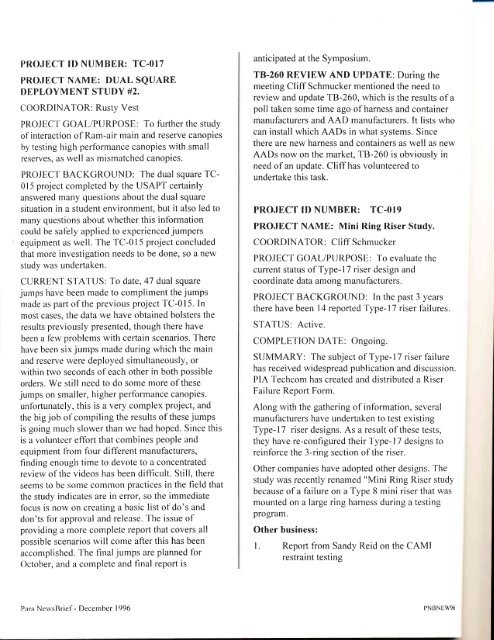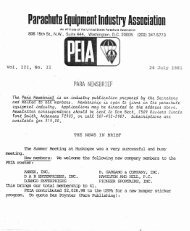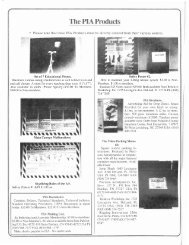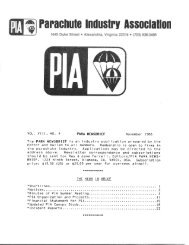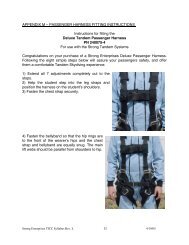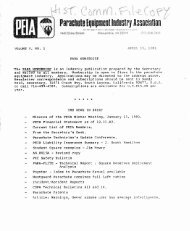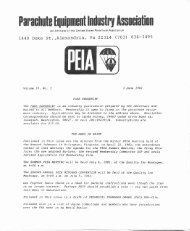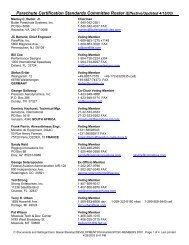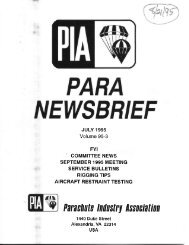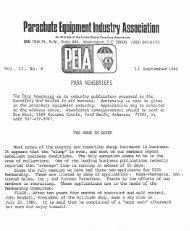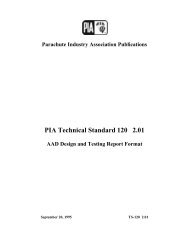'r#jt,3lll"o,,', - Parachute Industry Association
'r#jt,3lll"o,,', - Parachute Industry Association
'r#jt,3lll"o,,', - Parachute Industry Association
Create successful ePaper yourself
Turn your PDF publications into a flip-book with our unique Google optimized e-Paper software.
PRO.IECT ID NUMBER: TC-O17<br />
PRO.IECT NAME: DUAL SQUARE<br />
DEPLOYMENT STUDY #2.<br />
COORDINATOR: Rusty Vest<br />
PROJECT GOAL/PURPOSE: To further the study<br />
of interaction of Ram-air main and reserve canopies<br />
by testing high performance canopies with small<br />
reserves, as well as mismatched canopies.<br />
PROJECT BACKGROUND: The dual square TC-<br />
015 project completed by the USAPT certainly<br />
answered many questions about the dual square<br />
situation in a student environment, but it also led to<br />
many questions about whether this information<br />
could be safely applied to experienced jumpers<br />
equipment as well. The TC-01 5 project concluded<br />
that more investigation needs to be done, so a new<br />
study was undertaken.<br />
CURRENT STATUS: To date, 47 dual square<br />
jumps have been made to compliment the jumps<br />
made as part of the previous project TC-01 5. In<br />
most cases. the data we have obtained bolsters the<br />
results previously presented, though there have<br />
been a few problems with certain scenarios. There<br />
have been six jumps made during which the main<br />
and reserve were deployed simultaneously, or<br />
within two seconds of each other in both possible<br />
orders. We still need to do some more of these<br />
jumps on smaller, higher performance canopies.<br />
unfortunately, this is a very complex project, and<br />
the big job of compiling the results of these jumps<br />
is going much slower than we had hoped. Since this<br />
is a volunteer eflbrt that combines people and<br />
equipment from four different manufacturers,<br />
finding enough time to devote to a concentrated<br />
review of the videos has been difficult. Still, there<br />
seems to be some common practices in the field that<br />
the study indicates are in error, so the immediate<br />
focus is now on creating a basic list of do's and<br />
don'ts for approval and release. The issue of<br />
providing a more complete report that covers all<br />
possible scenarios will come after this has been<br />
accomplished. The finaljumps are planned for<br />
October, and a complete and final report is<br />
anticipated at the Symposium.<br />
T8-260 REVIEW AND UPDATE: During the<br />
meeting Cliff Schmucker mentioned the need to<br />
review and update TB-260, which is the results of a<br />
poll taken some time ago of hamess and container<br />
manufacturers and AAD manufacturers. It lists who<br />
can install which AADs in what systems. Since<br />
there are new harness and containers as well as new<br />
AADs now on the market, T8-260 is obviously in<br />
need of an update. Cliff has volunteered to<br />
undertake this task.<br />
PROJECT ID NUMBER: TC-019<br />
PROJECT NAME: Mini Ring Riser Study.<br />
COORDINATOR: Cliff Schmucker<br />
PROJECT GOAL/PURPOSE: To evaluate the<br />
current status of Type-17 riser design and<br />
coordinate data among manufacturers.<br />
PROJECT BACKGROUND: In the past 3 years<br />
there have been l4 reported Type-17 riser failures.<br />
STATUS: Active.<br />
COMPLETION DATE: Ongoing.<br />
SUMMARY: The subject of Type-17 riser failure<br />
has received widespread publication and discussion.<br />
PIA Techcom has created and distributed a Riser<br />
Failure Reporl Form.<br />
Along with the gathering of information, several<br />
manufacturers have undertaken to test existing<br />
Type-17 riser designs. As a result of these tests,<br />
they have re-configured their Type- l7 designs to<br />
reinforce the 3-ring section of the riser.<br />
Other companies have adopted other designs. The<br />
study was recently renamed "Mini Ring Riser study<br />
because of a failure on a Type 8 mini riser that was<br />
mounted on a large ring harness during a testing<br />
program.<br />
Other business:<br />
L<br />
Report from Sandy Reid on the CAMI<br />
restraint testins<br />
Para NewsBrief - December 1996<br />
PNBNEW96


